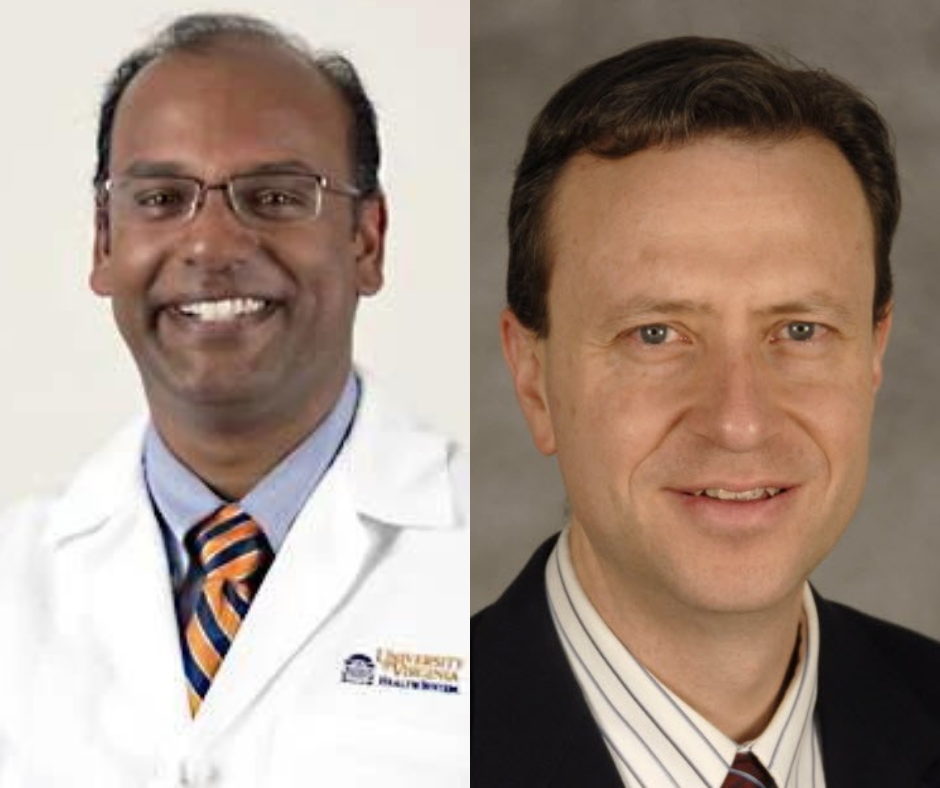High-field cardiovascular MRI makes sustained progress
Cardiovascular MR (CVMR) imaging has become a valuable diagnostic modality.
Cardiovascular MR (CVMR) imaging has become a valuable diagnostic modality. The need for speed and efficiency when imaging cardiovascular structures has helped to drive the development of rapid imaging techniques and advanced MR hardware.
The growing availability of high-field MRI systems is now prompting interest in 3T cardiovascular MRI. The move from 1.5T to 3T means a doubling in signal-to-noise ratio. Subsequent gains in contrast-to-noise ratio, imaging speed, and efficiency can be translated into added diagnostic value (SNR).
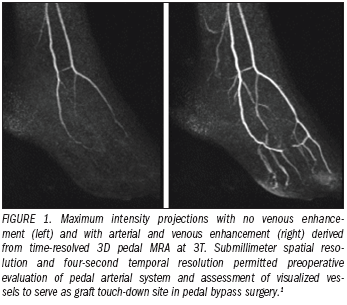
Many of the high-field cardiovascular MRI applications earn the moniker of "advanced techniques." High-field cardiovascular MRI has been regarded as one of the most challenging MR applications owing to practical obstacles associated with magnetic field inhomogeneities, radiofrequency nonuniformities across the heart, and RF power deposition constraints.
CVMR is an area in which 3T imaging boasts a number of advantages over 1.5T. Gains in spatial and temporal resolution can be invested in streamlining structural and functional cardiovascular imaging and can also be used to facilitate targeted tissue characterization and improve access to physiological information.
ADDED VALUE
First-pass contrast-enhanced MR angiography is a particularly appealing candidate for high-field CVMR. Contrast between blood vessels and background tissue on 3T images is superior to that on images acquired at 1.5T.
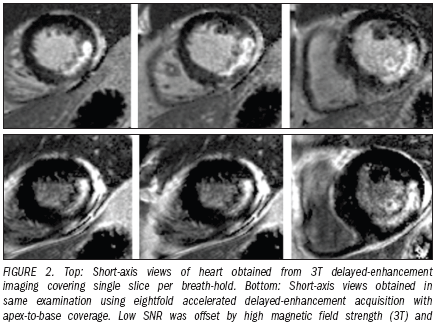
High-field MRA thrives on turning SNR into speed to capture the arterial phase of contrast enhancement. The benefits of high-field MRA may be exploited to increase anatomic coverage or spatial resolution within a given imaging time. This allows comprehensive scanning of any target vessel territory, while avoiding the frequently encountered difficulty of truncated anatomy. Continuous volumetric, time-resolved MRA can also be performed with temporal resolution that would be unattainable at 1.5T (i.e., two to four seconds). This makes it possible to evaluate contrast dynamics or to distinguish arterial from venous phases without substantially sacrificing the spatial resolution.
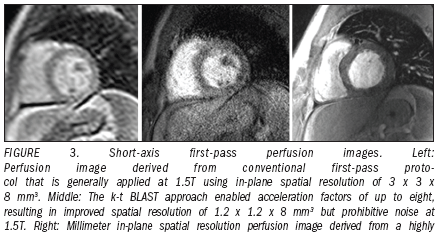
High-field imaging may also open up new clinical territory. The extension of MRA to include submillimeter spatial resolution imaging of tiny peripheral vessels (Figure 1), for example, may allow MRI to replace digital subtraction angiography for vessel flow and assessment prior to bypass surgery.1 This approach has been impossible at 1.5T.
Established cardiovascular MRI assessment of ischemic heart disease and myocardial viability includes delayed contrast-enhanced imaging. At higher magnetic field strength T1 prolongation in normal myocardium may make it easier to differentiate healthy and infarcted tissue during delayed contrast-enhanced imaging.

The traditional approach is confined to one slice per breath-hold, leading to examination times of 10 to 15 minutes. Long scan times are uncomfortable for patients. The contrast agent concentration in tissue also changes considerably over the course of the examination.
A synergy between high-field MRI and parallel imaging techniques can produce whole-heart coverage delayed-enhancement imaging in a single breath-hold (Figure 2). This approach increases patient comfort and ensures uniform suppression of healthy myo-cardium for all imaged sections.2
The merits of otherwise unattainable SNR at 3T together with improvements in acquisition speed promise to advance first-pass myocardial per-fusion-weighted imaging (PWI). Obstacles to broader clinical acceptance of conventional first-pass PWI remain, however. These include the limited anatomic coverage that is achievable and the limited in-plane spatial resolution (approximately 3 x 3 mm2). Limited spatial resolution can produce Gibbs ringing image artifacts that can mimic subendocardial perfusion deficits. The artifacts vanish with increasing matrix size, a change that would also help to improve the spatial resolution.
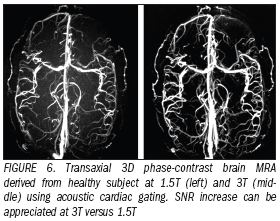
The baseline SNR advantages of 3T MRI can be used in conjunction with parallel imaging to achieve (sub)millimeter in-plane spatial resolution with single heartbeat temporal resolution. The image quality produced by eightfold accelerated PWI, for example, is superior to that attained by the conventional approach (Figure 3).
The ability to produce exquisite in-plane spatial resolution may increase the diagnostic value of myocardial perfusion assessments and support the extension of this technique to the right ventricle. The temporal fidelity of massively accelerated perfusion techniques must be viewed with caution. With sufficient acceleration, however, PWI should be feasible even for 3D whole-heart coverage.
(UN)SOLVED PROBLEMS
Steady-state free precession (SSFP) imaging techniques provide consistent high native contrast between the myocardium and ventricular cavity throughout the cardiac cycle. This makes them ideal for tracking and visualizing rapidly moving cardiac structures using dynamic cine imaging. Observation of moving structures is of paramount clinical relevance for the assessment of cardiac morphology, myocardial contractile function, and wall motion.
SSFP cine MRI is a clinical workhorse at 1.5T. But it remains challenging at 3T due to its sensitivity to adverse off-resonance effects and physiological constraints such as RF power deposition. Moving back to spoiled gradient-echo cine imaging is not an appropriate interim solution, particularly if extra contrast is needed to enhance the poor native blood/ myocardium contrast.3 Gradient-echo cine imaging, used previously at 1.5T, is prone to motion and flow artifacts.
Solving fundamental problems associated with SSFP will provide a way out of the current dilemma. Research to make SSFP less sensitive to B0 inhomogeneities and off-resonance effects continues (Figure 4). Dedicated shimming procedures, for example, have been proposed to reduce off-resonance effects. The clinical use of these procedures has been demonstrated, though its commercial availability is still limited.4
Wideband SSFP, which uses alternating repetition times to increase resilience to off-resonance effects, could be another possibility.
These improvements, together with the SNR benefit of 3T and the speed gains from parallel imaging, should increase the number of cardiac phases in SSFP cine imaging. This will enhance temporal resolution without exceeding clinically tolerable breath-hold times. The gains may alternatively be used to obtain single breath-hold whole-heart 3D cine acquisitions with acceptable spatial and temporal resolution. These are particularly desirable, not least because they can be reformatted retrospectively to obtain multiple different cardiac views.
Some of the inherent advantages of high-field MRI in current clinical practice are offset by the challenge of synchronizing data acquisition with the cardiac cycle. Technologies such as ECG and even advanced vector cardiography (VCG) are corrupted by interference with electromagnetic fields and magnetohydrodynamic effects, especially at ultrahigh magnetic field strengths. Artifacts in the ECG/VCG trace and T-wave elevation may be misinterpreted as R-waves, resulting in erroneous triggering. The motion artifacts will also compromise image quality.
A noninvasive acoustic cardiac triggering approach has been proposed to improve the reliability of cardiac gating (Figure 5).5 This "MR stethoscope" technique does not expose patients to the risk of high voltage induction or burns. It is suitable for use with a broad range of magnetic field strengths (Figure 6), easy to use, reliable, comfortable for patients, and insusceptible to electromagnetic fields.
High-field MRI techniques should help support emerging applications in cardiovascular MRI that are restricted at 1.5T by SNR and magnetic field-dependent constraints. High-field MRI opens the door to susceptibility-weighted imaging, for example, based on the superlinear relationship between magnetic field strength and microscopic B0 inhomogeneities.
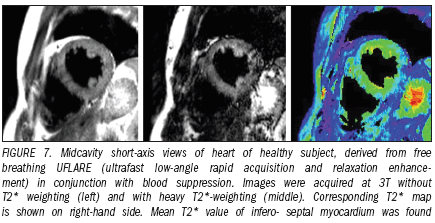
Some inherent advantages of T2*-weighted cardiovascular MRI are not being realized in current clinical practice because they are being offset by the intrinsic limitations of gradient-echo or echo planar imaging techniques. Obstacles to T2* mapping of the heart may be addressed by free breathing, cardiac gated, susceptibility-weighted fast spin-echo MRI, in conjunction with black blood preparation and navigator-gated respiratory motion compensation (Figure 7).6 Images generated by this approach are free from geometric distortion, unlike those produced by echo-planar imaging.
The above approach may also be used to quantify myocardial iron content, track cells or devices labeled with superparamagnetic iron oxide particles, and offer blood oxygen level-dependent mapping of myocardial perfusion deficits. The ability to image changes in tissue oxygenation could potentially address some of the spatial and temporal resolution constraints associated with conventional first-pass perfusion MRI. It may also obviate exogenous contrast, which could be prudent in light of recent reports linking MRI contrast to cases of nephrogenic systemic fibrosis.7
OVER THE HORIZON
The full range of what is possible with high-field cardiovascular MRI has not yet been realized. The added diagnostic value of techniques that are being used clinically, however, is expected to drive future technological developments. Commercial 7T MRI systems are already looming on the horizon for preclinical research applications.
An optimistic practitioner might envisage that in the future, with appropriate hardware design and customized imaging protocols, a comprehensive cardiovascular MRI examination could be compressed from 30 to 45 minutes into a few breath-holds or a short period of free breathing. This is merely a vision at the moment, though it continues to motivate new basic and clinical research into high-field cardiovascular MRI.
Achieving this goal will require strategic research-driven jointly by scientists, clinicians, and industry-devoted to developing high-field MRI methodology that can resolve and characterize physiological and pathophysiological processes and mechanisms in organs and tissue, and at the cellular and subcellular level. This research should, of course, be transferable from the basic research environment to routine clinical applications.
The future of today's advanced high-field cardiovascular MRI techniques remains intriguing. The field is evolving and also maturing. The door is open for cardiovascular imaging experts to use high-field MRI to probe more deeply into matters of the heart.
What New Lung MRI Research Reveals About Post-COVID-19 Conditions in Children and Adolescents
February 25th 2025Adolescents with post-COVID-19 conditions had 37 percent lower quantified lung perfusion than healthy control participants on phase-resolved functional lung MRI, according to findings from a recent prospective study.


















